Inside The New York Botanical Garden
Exhibitions
Posted in Exhibitions, The Edible Garden on July 9 2010, by Sonia Uyterhoeven
Chef Keith Snow Grows His Own; Shares Secrets, Tips
Many Americans want to take part in the harvest revolution and eat foods grown at home to ensure freshness, good taste, and reasonable cost. But what if you live in an apartment building—are you out of luck? Actually, no. Many people who live in urban areas around the country are taking part in the local food craze by growing food in containers.
Before you run out to the nursery to get started, consider whether your balcony or rooftop can handle the weight and whether your building permits it: A large container of wet soil can weigh 50–100 pounds or more. Multiply that by the number of containers you’d like, and check whether your site can handle the extra load. (If regulations do not allow for you to grow outdoors, you can certainly grow herbs indoors near a sunny window.)
Once you’ve resolved where to place your plants, you’ll need to decide what to grow. Some plants are perfectly suited to containers, others are not. I like to advise people to create a kitchen garden in containers that can produce herbs, lettuces, tomatoes, cucumbers, eggplant, and peppers. These crops can thrive in containers and provide a lot of food and recipe diversity.
Read More
Posted in Exhibitions, The Edible Garden on July 8 2010, by Plant Talk
 |
Cathy Erway, author of The Art of Eating In, will present cooking demonstrations at The Edible Garden Conservatory Kitchen on Saturday, July 10, at 1 and 3 p.m.. |
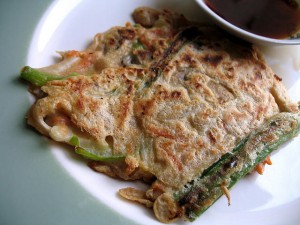 Perhaps you’ve tried them at Korean restaurants, with spicy kimchee in the batter. Maybe you’ve heard of them and guessed they were more or less like scallion pancakes at Chinese restaurants, but with more stuff. Maybe you’ve even taken a crack at making them at home, with strips of leftover meat or seafood. In any case, you are probably well aware of how simple yet delicious a crisp, savory pancake hot off the pan can be. I’ve found that holds true with almost any ingredient you mix into the batter.
Perhaps you’ve tried them at Korean restaurants, with spicy kimchee in the batter. Maybe you’ve heard of them and guessed they were more or less like scallion pancakes at Chinese restaurants, but with more stuff. Maybe you’ve even taken a crack at making them at home, with strips of leftover meat or seafood. In any case, you are probably well aware of how simple yet delicious a crisp, savory pancake hot off the pan can be. I’ve found that holds true with almost any ingredient you mix into the batter.
My favorite way to enjoy savory pancakes, though, is just with fresh veggies. Red onions and apples is a wildly satisfying combo in the winter. Shredded carrots and parsnips go great together, too. But in the summer, the vibrant flavors of everything that’s in season can’t be beat. Try making the pancakes with thinly sliced peppers of all shades and mixing fresh corn into the batter along with scallions and another type of onion. For the recipe below, I use a filling of mostly shredded zucchini.
Read More
Posted in Emily Dickinson, Exhibitions on July 7 2010, by Plant Talk
 |
Jane Dorfman is Reference Librarian/Exhibitions Coordinator in the LuEsther T. Mertz Library. |
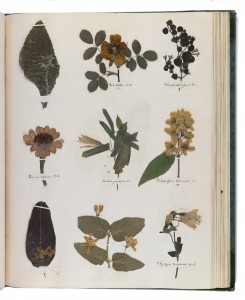 How did Emily Dickinson prepare her herbarium? That is the topic addressed in the current window display of the LuEsther T. Mertz Library’s Rare Book and Folio Room.
How did Emily Dickinson prepare her herbarium? That is the topic addressed in the current window display of the LuEsther T. Mertz Library’s Rare Book and Folio Room.
At 14 years of age, Dickinson, inspired by her readings and botanical studies at Amherst Academy, gathered, dried, pressed, mounted, and identified over 400 plants for her herbarium. She was enthusiastic about the project. She asked her friend Abiah Root in a letter if she had made a herbarium yet and encouraged her to pursue such a project. Dickinson even enclosed a geranium leaf for her friend to press.
In the Library’s William D. Rondina and Giovanni Foroni LoFaro Gallery exhibition of Dickinson’s life, which runs through August 1, a digitized version of the poet’s herbarium is on display. Made available through Turn the Pages Technology, visitors can view Dickinson’s original herbarium virtually by “turning” the pages on a touchscreen. A printed version of Dickinson’s herbarium is included in the Rare Book and Folio Room display.
This small exhibit shows how 19th-century botany enthusiasts created herbaria. The collecting tin (known as a vasculum) belonging to the celebrated botanist John Torrey is on display as well as a botany text by noted instructor Mrs. Almira Lincoln Phelps, a text that Dickinson used in her studies.
Also on view are the materials used in creating a herbarium today, including glue, twine, mounting paper, blotting paper, and a herbarium press. In addition, dried specimens of Monotropa uniflora (Indian pipe) and Heliotropium arborescens L. (heliotrope), two of Dickinson’s favorite plants, are presented, courtesy of the Garden’s William and Lynda Steere Herbarium..
The Rare Book and Folio Room display can be viewed during Library hours through Labor Day.
Posted in Exhibitions, The Edible Garden on July 6 2010, by Sonia Uyterhoeven
 |
Sonia Uyterhoeven is Gardener for Public Education. Join her each weekend for home gardening demonstrations on a variety of topics in the Home Gardening Center. |
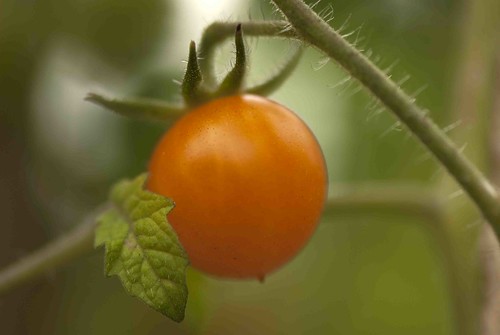 Garden writer Sydney Edison studies how great art masters combine color on their canvas and uses those lessons as inspiration for the color combinations in her patio displays. Color in the vegetable garden is equally important. It can transform an ordinary or utilitarian space into a work of art.
Garden writer Sydney Edison studies how great art masters combine color on their canvas and uses those lessons as inspiration for the color combinations in her patio displays. Color in the vegetable garden is equally important. It can transform an ordinary or utilitarian space into a work of art.
Design your vegetable garden with color in mind by paying attention to the color of fruit, flowers, and foliage. A bed of yellow and red peppers can be accentuated by repeating the color with a surrounding edge of marigolds. Scarlet runner beans can climb up vertical structures that will pick up the hot color theme.
Repeating color themes is one of the simplest and most effective ways to both literally and figuratively soup-up your vegetable garden. This can be done with vegetables but also enhanced by colorful herbs and summer annuals that can find their way into a vase on the kitchen table.
Read More
Posted in Exhibitions, Programs and Events, The Edible Garden on July 2 2010, by Plant Talk
Children Learn How Pollinators Turn Flowers to Fruits
 |
Noelle V. Dor is Museum Education Intern in the Everett Children’s Adventure Garden. |
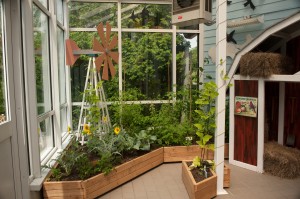 As the school year winds to a close and summer settles in, The New York Botanical Garden invites us to delight our senses and our bellies with The Edible Garden: Growing and Preparing Good Food. Visitors are exposed to a wide variety of edible roots, shoots, and fruits and also experience the many ways our favorite foods go from plant to plate.
As the school year winds to a close and summer settles in, The New York Botanical Garden invites us to delight our senses and our bellies with The Edible Garden: Growing and Preparing Good Food. Visitors are exposed to a wide variety of edible roots, shoots, and fruits and also experience the many ways our favorite foods go from plant to plate.
In its Flowers-to-Fruits program, the Everett Children’s Adventure Garden highlights one essential part of this transformative process: pollination. Here families explore the diversity of flower colors, shapes, and scents as well as the mutually beneficial relationships between flowers and the animals they attract.
The word pollination probably conjures up in most people the classic image of a bee buzzing from flower to flower. While this visual is definitely appropriate, many other animals—butterflies, moths, hummingbirds, bats, ants—act as important pollinators as well. They gain nourishment from the sweet nectar of flowers and, in turn, the flowers are able to change into fruits. Seeing pollination in action throughout the Garden makes me wonder how many of the fruits we eat result from this intricate plant–animal exchange.
Read More
Posted in Exhibitions, The Edible Garden on July 1 2010, by Plant Talk
Oceana Pastry Chef Jansen Chan Shares Preview of 2 New Creations
 |
Jansen Chan is Executive Pastry Chef of Oceana in New York. He will give cooking demonstrations at The Edible Garden on Sunday, July 4. |
Summer is the toughest time for any pastry chef. The abundance of great seasonal produce to put on the menu is too overwhelming. Whether it’s cherries, peaches, strawberries, blueberries or melons, I love them all. When creating a new dish, I want to remain true to the fruit and allow its complexity to shine through—usually the produce is the star with delicious, supporting players to give contrast in texture and flavors.
For The Edible Garden this year, I have the honor of celebrating raspberries. I’ve created two dishes for the event, designed for the everyday home chef. I wanted to make easy dishes that people wouldn’t be intimidated by. I also wanted to make something that wasn’t too plain or boring.
I’m most excited by the Raspberry Yogurt Fool with Basil. A fool (besides the obvious) is simply a fruit puree folded with whipped cream. Here, I’ve lightened it with some Greek yogurt and sweetened it with just a touch of honey. The fresh basil brings freshness and relief from the natural tartness in the dishes. It’s the perfect, cool summer treat!
My other dish is pure indulgence: It’s an Upside-Down Raspberry Chocolate Cake. It’s exactly as it sounds—a moist, chocolate cake baked with a sticky, sweet, and tart raspberry topping. How could it go wrong?
Come to The Edible Garden Sunday to see Chef Jansen Chan prepare these desserts, so that you can make them at home.
Get Your Tickets
Posted in Programs and Events, The Edible Garden on June 28 2010, by Plant Talk
Fresh, Local Foods From Farms Converts This City-bred Aficionado
 |
Luis G. Perreaux Jr. is the Botanical Garden’s Public Education Greenmarket Intern this summer and fall. |
 As a native of the Bronx, I grew up thinking that food was only available at supermarkets and bodegas, and I had no idea how it got there. Not until I visited a farm in the Dominican Republic, where my parents were born, did I realize that the growing of food is a collaborative process that connects people, plants, and animals in ways I could never have imagined on my own.
As a native of the Bronx, I grew up thinking that food was only available at supermarkets and bodegas, and I had no idea how it got there. Not until I visited a farm in the Dominican Republic, where my parents were born, did I realize that the growing of food is a collaborative process that connects people, plants, and animals in ways I could never have imagined on my own.
I loved how the farmer would constantly rotate crops and livestock so the soil would stay fertile and moist. After that memorable trip, I began to care more about where my foods came from and whether they were sustainable or not. Then I found the Greenmarket at 161st and Grand Concourse, where the old Yankee Stadium used to be, with its fresh, locally grown, and nutritious produce. I have been a devoted fan of Greenmarkets ever since.
Read More
Posted in Exhibitions, Gardening Tips, The Edible Garden on June 28 2010, by Sonia Uyterhoeven
 |
Sonia Uyterhoeven is Gardener for Public Education. Join her each weekend for home gardening demonstrations on a variety of topics in the Home Gardening Center. |
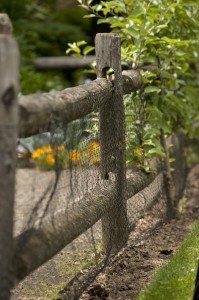 Last week I blogged about the historic and design aspects of ornamental vegetable gardens. This week I take a look at some of their basic features.
Last week I blogged about the historic and design aspects of ornamental vegetable gardens. This week I take a look at some of their basic features.
Many traditional kitchen gardens have some kind of boundary or enclosure that not only separates the garden from its surroundings but often provides a practical barrier to keep out unwanted pests. Classic boundaries include brick walls, stonewalls, wooden fences, wattle or woven fences, and hedges.
A simple split-rail wooden fence lined with chicken wire to keep out rabbits surrounds the vegetable garden in the Botanical Garden’s Home Gardening Center (see photo). “A flat-top picket fence would give it a Colonial feel, while a more open and rustic setting could be created by a zigzag wooden fence,” says Chris from a fence company in Louisville, KY. The hardscape of the garden will help set the mood and contribute to the overall design. Enclosure creates a sense of intimacy and gives a framework to your garden.
Read More
Posted in Exhibitions, The Edible Garden on June 25 2010, by Plant Talk
Abigail Kirsch Booksigning and Chef Cooking Demos This Weekend
 |
Alison Awerbuch is Chief Culinary Officer and Partner of Abigail Kirsch Catering Relationships. |
Editor’s note: Abigail Kirsch Catering Relationships, which manages the Botanical Garden’s two cafes and the on-site catered events, will be featured this Saturday, June 26, during The Edible Garden. Corporate Executive Chef Mark Gagnon will present two cooking demonstrations, and Abigail Kirsch will sign her cookbooks, which will be available for purchase.
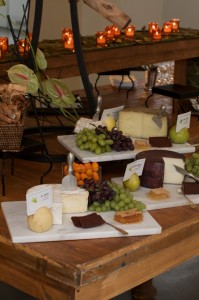 When creating menu items and presentations, we at Abigail Kirsch Catering Relationships pull from our surroundings and are often inspired by the garden. Whenever possible, we incorporate local, sustainable vegetables, fruits, and herbs into our offerings, and there is no better time for this in New York than in the spring, summer, and fall! We tap on local farmers for the freshest and most flavorful items to enhance our menus.
When creating menu items and presentations, we at Abigail Kirsch Catering Relationships pull from our surroundings and are often inspired by the garden. Whenever possible, we incorporate local, sustainable vegetables, fruits, and herbs into our offerings, and there is no better time for this in New York than in the spring, summer, and fall! We tap on local farmers for the freshest and most flavorful items to enhance our menus.
Below are inspired ways you can incorporate the garden when you entertain this summer.
Green Market Buffet
Whether close to home or far away, we are always inspired by what is happening in that locale’s food scene. For instance, a recent weekend in the Catskills offered a lush landscape of a thousand shades of green; an abundance of local, sustainable foods; and aisles upon aisles of retro chic at flea markets (although you have to dig hard to find just the right pieces).
This inspired me to create a “green market buffet” where our organic food presentations were displayed on rustic farm tables and our entire menu was served on a wonderful assortment of green pressed glass, rustic wood, and galvanized metal trays. Mix-and-match plates, flatware, and glassware along with retro linen created an uncomplicated, retro look.
Read More
Posted in Exhibitions, Programs and Events, The Edible Garden on June 23 2010, by Plant Talk
 |
Nick Leshi is Associate Director of Public Relations and Electronic Media. |
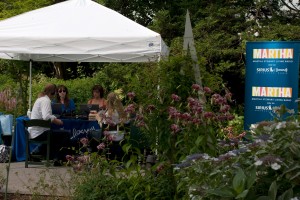 Last year, Martha Stewart Living Radio visited The New York Botanical Garden for a full day of live broadcasting. We are happy to report that they are returning for another daylong broadcast from the Jane Watson Irwin Perennial Garden, near Martha Stewart’s Culinary Herb Garden.
Last year, Martha Stewart Living Radio visited The New York Botanical Garden for a full day of live broadcasting. We are happy to report that they are returning for another daylong broadcast from the Jane Watson Irwin Perennial Garden, near Martha Stewart’s Culinary Herb Garden.
From 7 a.m. until 5 p.m. on June 24, subscribers of Sirius XM satellite radio (Sirius 112 and XM 157) not only can listen to all their favorites—Morning Living, Whole Living, Everyday Food, Homegrown, Living Today, and Eat Drink—but see them airing live. (Even if you are not a subscriber to Sirius XM you can see Martha Stewart’s team of lifestyle experts broadcasting live at the Garden!) For a full schedule, visit Martha Stewart Living Radio.
A number of interesting guests are scheduled to chat about a broad range of topics, including gardening, food, holistic therapy, and more. New York Botanical Garden experts who will be interviewed include Jodie Colon, Compost Educator, NYC Compost Project in the Bronx; Annie Novak, Coordinator of the Children’s Gardening Program; Kristin Schleiter, Curator of Outdoor Gardens; Sonia Uyterhoeven, Gardener for Public Education; and Peter Kukielski, Peggy Rockefeller Rose Garden Curator.
Among the topics of discussion will be The Edible Garden, the four-month long festival of growing and preparing good food, which runs through October 17 at the Botanical Garden.
Get your tickets now for The Edible Garden.

















